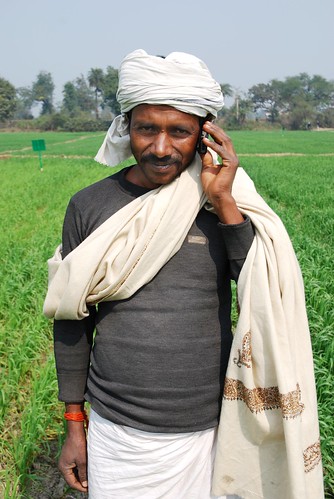Some cool téléphone mobile images:
Farmer with his mobile phone in Bihar, India

Image by CIMMYT
A farmer speaks on his mobile telephone while at work in a wheat field close to the Pusa site of the Borlaug Institute for South Asia (BISA), in the Indian state of Bihar.
Poor availability of and access to information can be an important factor in low productivity and slow technology uptake. Information and communication technologies provide new and effective ways to reach farmers with agricultural information. Mobile telephones have become by far the most widespread means of communicating and sharing information in many South Asian and African countries. Mobile phone-based services are a powerful way of enhancing the availability of knowledge and information, leading to greater adoption of new technologies, reduced transaction costs, better market efficiencies, etc., and ultimately improved livelihoods for farmers.
BISA is a non-profit research institute dedicated to the improvement of food security and reduction of hunger in South Asia. It is a collaborative effort between the International Maize and Wheat Improvement Center (CIMMYT), The Indian Council for Agricultural Research (ICAR), and the Government of India. BISA’s objective is to harness the latest technology in agriculture to improve farming productivity and sustainably meet the demands of the future. More than just a bricks-and-mortar institute, BISA is a commitment to the people of India. It is co-located in three Indian states—Punjab, Bihar, and Madhya Pradesh—each of which contains varied agro-ecological zones, representing many of the environments of South Asia. Farmer information technologies are one of the areas of future development for BISA Pusa.
For more on the CIMMYT Agriplex information service for farmers, see: blog.cimmyt.org/?p=6101.
For more about BISA, see: bisa.cimmyt.org/.
Photo credit: M. DeFreese/CIMMYT.
Farmer with his mobile phone in Bihar, India

Image by CIMMYT
A farmer speaks on his mobile telephone while at work in a wheat field close to the Pusa site of the Borlaug Institute for South Asia (BISA), in the Indian state of Bihar.
Poor availability of and access to information can be an important factor in low productivity and slow technology uptake. Information and communication technologies provide new and effective ways to reach farmers with agricultural information. Mobile telephones have become by far the most widespread means of communicating and sharing information in many South Asian and African countries. Mobile phone-based services are a powerful way of enhancing the availability of knowledge and information, leading to greater adoption of new technologies, reduced transaction costs, better market efficiencies, etc., and ultimately improved livelihoods for farmers.
BISA is a non-profit research institute dedicated to the improvement of food security and reduction of hunger in South Asia. It is a collaborative effort between the International Maize and Wheat Improvement Center (CIMMYT), The Indian Council for Agricultural Research (ICAR), and the Government of India. BISA’s objective is to harness the latest technology in agriculture to improve farming productivity and sustainably meet the demands of the future. More than just a bricks-and-mortar institute, BISA is a commitment to the people of India. It is co-located in three Indian states—Punjab, Bihar, and Madhya Pradesh—each of which contains varied agro-ecological zones, representing many of the environments of South Asia. Farmer information technologies are one of the areas of future development for BISA Pusa.
For more on the CIMMYT Agriplex information service for farmers, see: blog.cimmyt.org/?p=6101.
For more about BISA, see: bisa.cimmyt.org/.
Photo credit: M. DeFreese/CIMMYT.

Poster un Commentaire